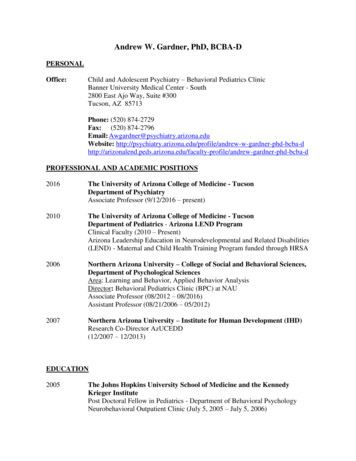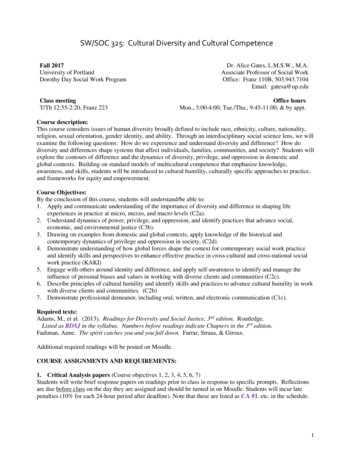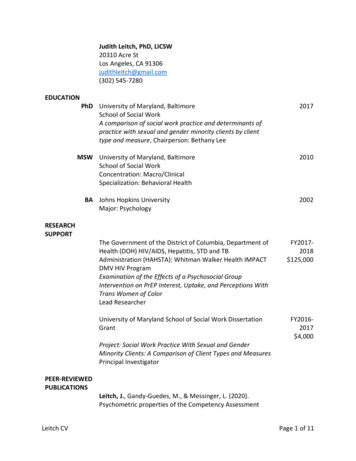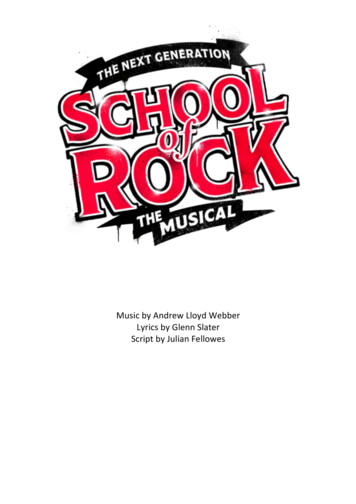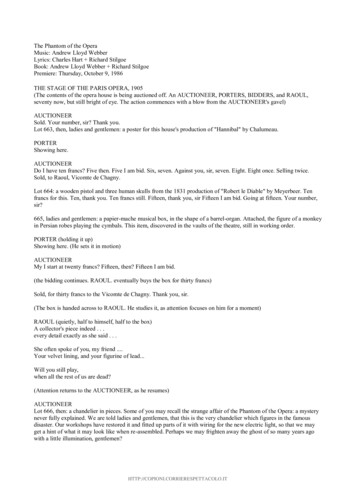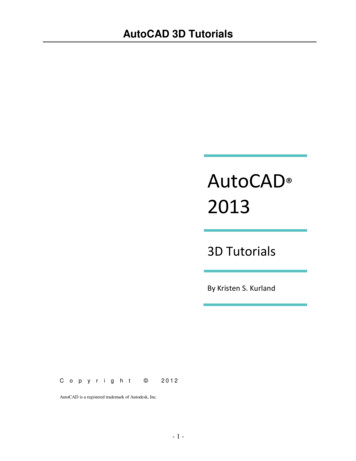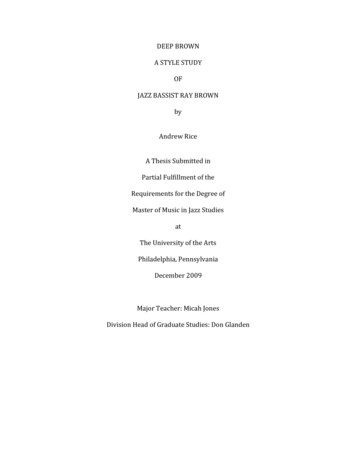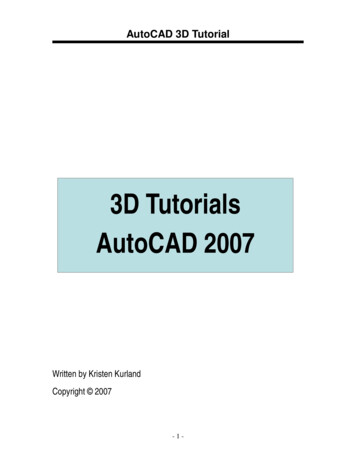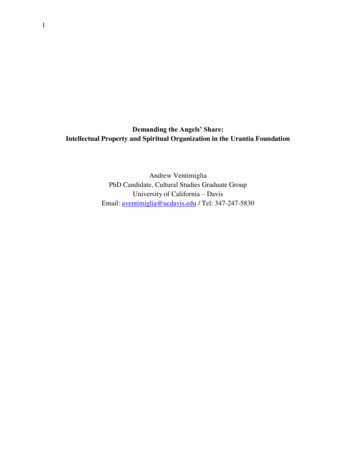
Transcription
1Demanding the Angels’ Share:Intellectual Property and Spiritual Organization in the Urantia FoundationAndrew VentimigliaPhD Candidate, Cultural Studies Graduate GroupUniversity of California – DavisEmail: aventimiglia@ucdavis.edu / Tel: 347-247-5830
2Demanding the Angels’ Share:Intellectual Property and Spiritual Organization in the Urantia FoundationAbstract: This article explores the role that intellectual property plays as it shapes thecirculation and use of ‘The Urantia Book,’ a divinely revealed text published in 1955 andembraced by a community of believers. For many modern spiritual communities – of which theUrantian community is a telling example – their coherence no longer lies in a centralizedinstitution like the church but instead in a shared dedication to sacred texts and other religiousmedia. Thus, intellectual property has become an effective means to administer the ephemeralbeliefs and practices mediated by these texts. This article explores a number of the UrantiaFoundation’s cases to demonstrate how intellectual property law can be used to maintain andadjudicate social relations rather than simply determining the proper allocation of ownershipover a contested good. This project uses the legal battles of the Urantia Foundation as anopportunity to examine how religious communities ethically justify forms of ownership inreligious goods and to highlight the incongruities between theories of authorship, originality andownership within spiritual communities and those embedded in the law. Further, by focusing onintellectual property in the religious world, I seek to answer the question: does religion belong tothe public domain?Keywords: Intellectual property, Public Domain, Spirituality, New Religious Movements,Authorship, Commodification,
3“Look at your Urantia Book. At the spine it is stitched and tightly bound together. Butaround the remaining edges, all of the pages are free. You can flip through them withease and turn to any page. The publishing responsibility of Urantia Foundation is likethat. By the copyright, the Foundation ‘stitches the spine so firmly’ that not a page can beadded or lost. But at the same time, the Book is flexible in that all who desire to study itmay open it and engage in the exhilarating quest for spiritual truth.”– Richard Keeler, President of the Urantia Foundation (1998-2004)1Religious organizations in the United States are increasingly turning to intellectualproperty law in order to assert control over sacred texts and other forms of religious media.Groups like the Worldwide Church of God, the Church of Scientology, Bikram Yoga, and OscarIchazo’s Arica School among others all exemplify this trend. By strategically deploying propertyrights in their religious media, these organizations successfully operate within the contemporaryspiritual marketplace, form new religious communities, and maneuver in juridical terrain that hasfew tools with which to adjudicate religious disputes.I explore the role that intellectual property plays as it shapes the circulation and use ofThe Urantia Book, a divinely revealed text published in 1955 and embraced by a small group ofbelievers. For many modern spiritual communities – of which the Urantian community is atelling example – their coherence no longer lies in a centralized institution like the church butinstead in a shared dedication to sacred texts and other religious media. This development hascreated an unexpected role for intellectual property, which is mobilized to maintain andadjudicate social relations rather than simply determining the proper allocation of ownershipover a contested good. I trace the legal battles of the Urantia Foundation to examine howreligious communities ethically justify forms of ownership in religious goods and to highlight theincongruities between theories of authorship, originality and ownership within spiritual1Richard Keeler, “From the President: Why Unity is Needed,” Urantian News 17:2 (Fall 1998).
4communities and those embedded in the law. Ultimately, I seek to answer the question: doesreligion belong to the public domain?Published in 1955, The Urantia Book consists of 196 different papers (totaling 2,097pages) describing the characteristics of humanity’s divine nature, the myriad journeys of the soulin the afterlife, the complex cosmology of the universe and countless other features of thespiritual environment. It was claimed to be authored by celestial beings responsible forpresenting a new revelation to Urantians (human inhabitants of the planet Urantia, also known asEarth) in order to assist in their evolutionary development and to foster their eventual inclusionin a greater cosmic citizenry. Over the course of thirty years, the papers were ‘received’2 by ananonymous sleeping person, transcribed and compiled into their current form in Chicago by aninformal group known as the Contact Commission. Before the publication of the papers, theContact Commission created the Urantia Foundation – a non-profit educational institution –formed to, “perpetually preserve inviolate the text of The Urantia Book and to disseminate theprinciples, teachings, and doctrines of The Urantia Book.”3 In their mission statement, theFoundation committed itself to the accomplishment of two complementary tasks: an act oftextual preservation of the divine revelation and an act of social outreach, circulating the newgospel for the twentieth century.The Urantia Book is an unwieldy, challenging text. It traces the history of humanity,beginning with descriptions of the Isle of Paradise where God lives at the center of the cosmos,continuing with the history and development of our local universe of Nebadon and home planetUrantia, and concluding with a new gospel “The Life and Teachings of Jesus,” in which Michael,2The Urantia Foundation rejects the terminology of ‘channeling’ or ‘automatic writing’ to explain the origins of TheUrantia Book.3“Urantia Foundation Declaration of Trust (1950),” Urantia Foundation, on-trust.
5the creator of our local universe, chose to descend to Urantia and live as a mortal in order tobetter understand how to rule his creation. Filled with book-specific terminology and written in amélange of styles varying from chapter to chapter, The Urantia Book provides a unique andintimidating challenge to new readers. The Foundation was thus tasked with figuring out the bestmethods for distributing and promoting this idiosyncratic book to a wider audience and forcultivating a robust community of readers who could responsibly interpret and apply theteachings of this new revelation.The Urantia Foundation quickly secured key intellectual property rights in the text. Byearly 1955, it had registered the copyright of The Urantia Book and attempted to trademark boththe word ‘Urantia’ and their central symbol of three blue concentric circles.4 The Foundation’slegal maneuvers were not simply a means to generate revenue or to protect the economic rightsof the book’s heavenly authors but rather a critical strategy for the fulfillment of theFoundation’s religious obligation to the divine revelation. In August of 1942 the RevelatoryCommission – the angels tasked with the responsibility of conveying their message to humanity– spelled out such obligation in no uncertain language:You have not done enough to safeguard your name. Make it safe for one generation sothe name Urantia cannot be pre-empted. In a common-law trust you hold the name. Youdo it also in a corporation. A corporation has status in law. You also do it in thecopyright. You must carefully register it with the division of government that I havelooked into, that controls trade relations, Trademark In all those ways you mustsafeguard the name. This is one of your most important duties. 54Trademarks in the name Urantia were unsuccessful in the fifties because there was not yet any public usage of thename. Registration for the marks “Urantia,” “Urantian” and the Concentric-Circles Symbol were secured in 1971.“Policy Regarding Use of Urantia Foundation’s Registered Marks: The Words ‘Urantia’ and ‘Urantian’ and theConcentric-Circles Symbol,” Urantia Foundation, -marks.5Reprinted in Thomas Kendall, “The Copyright and Trademarks,” October 10, 1984, http://urantiabook.org/archive/history/doc179.htm. None of the original messages conveyed to the Contact Commission weresaved, thus it is impossible to verify this particular message; however, the idea that the use of intellectual propertyby the Foundation was divinely mandated was common throughout the Foundation’s legal battles.
6The Foundation used its property rights to widely publish the book in the United States, developand fund translations, and administer to a robust network of licensed schools, organizations andreader groups dedicated to the revelation. It also repeatedly found itself defending its propertyrights in the courts.These actions have unintentionally contested the very nature of the book as religious text.Questions about the protections granted to divine authorship, the differences betweenchanneling, inspiration and original creation, and the tension between the religious freedom ofreaders and the monopoly rights granted by copyright and trademark have all found expression ina series of court cases beginning in the seventies and continuing for the next thirty years. In1993, Kristin Maaherra – who was being sued by the Urantia Foundation for distributing a fulllength digital version of the book on CD – clarified just what was at stake in these conflicts,writing, “By suing me, the Foundation has swallowed a poison pill. If they admit thesuperhuman authorship of the Papers in court, they lose the copyright. If they say they hired ahuman to write the Papers, they lose their credibility with the readers – not to mention theAncients of Days.”6By using intellectual property law to resolve conflicts around religious works, theFoundation willfully moved onto a juridical terrain that fails to recognize religious authority,favors the literary work, categorizes on the basis of authorial right, and measures value through adoctrine of originality. However, the Urantia Foundation’s legal actions derived from strong,religiously motivated rationales present within the community. They learned to articulate alegally recognizable defense of intellectual property rights in religious works without relying onarguments grounded in the moral rights of the individual author (since the texts in question are6Martin Gardner, Urantia: The Great Cult Mystery (Amherst: Prometheus Book, 1995), 413.
7divinely authored) or the economic rights of the cultural producer (since overzealous pursuit ofprofit damages claims to religious sincerity especially regarding the obligation to freely ‘spreadthe gospel’). Instead, they constructed a defense that was grounded in logics of care, stewardshipand control, imagining the property holder as custodian and caretaker for objects that are legallyowned by central institutions but symbolically owned by the whole community. This argument,however, belied complex internal struggles within the Foundation. While its legal actionsagainst property infringers were pursued to protect the work from outside interference, they werealso aimed at defining insider and outsider in the Urantian community. These cases were thusintimately implicated in and became battlegrounds for competing forms of religious communitywithin the Urantian social world.This article will use the intellectual property disputes of a marginal religious group likethe Urantia Foundation to look at new modes of spiritual organization developing in thetwentieth and twenty-first centuries and to examine what legal and organizational strategies areavailable to shape these new institutions. New religious movements like the Urantia communityfrequently define themselves against traditional American religion conceived as a communityorganized around a centralized church and subservient to denominational and congregationalhierarchies of power. Instead, Urantians and other similar contemporary spiritual movementsexperiment and innovate in their development of new networks of spiritual practitioners unitedby common interests but not bound by formal membership. Courtney Bender has aptly describedefforts to research these developing modes of spirituality as akin to ‘shoveling fog.’ However,the tendency to view spirituality as amorphous, dispersed and highly individualized neglects thevery real ways in which, “spirituality is produced in multiple social situations, including many
8that we regularly do not consider religious.” 7 This description aptly describes the ways in whichthe American courtroom has become an alternative space for the formation of spiritualorganization for the Urantia Foundation. In the absence of formal religious hierarchies andtraditions, the Urantia Foundation has attempted to create a coherent community through themechanisms of intellectual property law. 8 Intellectual property is uniquely suited to this task as ithelps determine the conditions of access and rules of use for cultural goods and in doing solitigates not just ownership claims but also the social relations constituted by and aroundcontested properties.The licensing agreements the Foundation created for its affiliate organizations such as thelocal chapters of the Urantia Brotherhood and the incipient international study groups providedconcrete links across centers of activity. Intellectual property thus provided the legal meansthrough which to create a structured network of followers that might otherwise have becomeincreasingly uncontrollable without a single organizational center of gravity. More importantly,these agreements provided social coherence in the absence of both a traditional church-basedorganizational structure and a unified community of interpretation, as Urantians have largelymaintained the value of individualized relationships to the divine and encouraged multipleavenues of interpretation.The licensing strategies of the Urantia Foundation were also meant to maintain aparticular configuration of community, one sturdy enough to rebuff external challenges (from thedistortions of mass media, the growing attacks of anti-cult activists, and the appropriation of TheUrantia Book by UFO religions and other ‘fringe groups’) but also flexible enough to allow thegrowth of the community and the spread of the revelations of The Urantia Book around the7Courtney Bender, The New Metaphysicals: Spirituality and the American Religious Imagination (Chicago:University of Chicago Press, 2010), 182.8Madhavi Sunder, “IP3,” Stanford Law Review 59:2 (2006): 274.
9world. How exactly to maintain the balance characteristic of a healthy spiritual organization wassomething not fully agreed upon within the community itself. For instance, different factionswithin the Urantia community had conflicting opinions about the degree to which The UrantiaBook should be advertised, how it should be introduced to people outside the community, howmuch the Foundation should charge for the book, and even how the book jacket and back covershould be designed in order to adequately entice new readers. Furthermore, the size andcomplexity of The Urantia Book demanded a particularly dedicated reader, and those who hadconquered the book’s substantial literary challenges were hesitant to make the book tooaccessible thereby robbing the book of its role as gatekeeper separating uncommitted readersfrom true members of the community. The legal battles involving The Urantia Book were asmuch challenges to hegemonic visions of the Urantian community as they were contests overeconomic and authorial rights. The Urantia Foundation was primarily threatened not by a loss ofrevenue in sales of The Urantia Book if it were to enter the public domain, but rather bycompeting conceptions of the developing community itself.Litigating Religious AuthorshipOn January 3, 1956 the Copyright Office issued a Certificate of Registration to theUrantia Foundation for The Urantia Book. A few years earlier, the Foundation had registered itsthree concentric circle service mark with the U.S. Patent and Trademark Office. Plans to secureintellectual property rights and its associated symbols had been decided early in the developmentof the movement. As early as 1932, members of the Contact Commission looked into themechanics of national and international registration and asked about the possibility of securing
10‘indefinite’ copyright.9 However, this proactive approach to securing rights was not pursued as amarket strategy, for the Foundation had no intentions of engaging in aggressive commercialdistribution of the book. Instead, at the same time that the Foundation was acquiring theirintellectual property rights, they were also constructing a carefully designed and spirituallymotivated policy of distribution for the book.The first extended analysis of the logic behind the Foundation’s copyright, written byPhilip Calabrese in 1973, encouraged the securing of intellectual property rights not only in orderto protect the sacred text and to monitor the ways that the book was being interpreted, but alsocontrol distribution in a manner that fit with their unique vision of ‘evolutionary growth.’Calabrese writes, “The copyright was a logical necessity to the plan of gradual presentation ofThe Urantia Book to Urantia. Such a copyright is simply necessary in order to control the rateand means of dissemination of The Urantia Book to Urantians.”10 The Foundation hoped tofoster a slow but persistent development of public awareness in the book, one copy at a time,from person to person, thus their formal distribution policy prohibited advertising, frowned uponattempts to publicize in any way other than word-of-mouth, and even discouraged introducingthe book to bookstores.11 This oddly anti-market distribution strategy was designed to prevent‘revolutionary growth,’ which was understood negatively as aggressive, impatient anduncontrollable and to foster a model in which the carefully planned movement of the bookbetween readers linked them into an ever-expanding network of believers.9Letter attributed to William Keith Kellogg to Acting Register of Copyrights, Library of Congress. November 1,1932. http://www.ubhistory.org/Documents/UC19321102 KelloggW 01.pdf. It seems that some of the UrantiaFoundation Trustees might appreciate Sonny Bono’s vision that ‘copyright should be forever.’ Lawrence Lessig,Free Culture: The Nature and Future of Creativity (New York: Penguin, 2004), 215.10Philip Calabrese, “Why has The Urantia Book been Copyrighted? An Analysis,” 1973,http://ubhistory.org/Documents/UC19730101 CalabreseP 04.pdf.11“Urantia Foundation Current Statement of Policy,” Urantia Foundation, May 7, 1958.http://www.ubhistory.org/Documents/UI19580517 ChristensenE 04.pdf ; “The Dissemination of The Urantia Bookand Statement on Publicity,” Urantia Association International, December, 1983. .pdf.
11While the Foundation enforced their policy of slow growth, an increasing number ofenthusiastic readers were eager to distribute the book more widely and to evangelize on behalf ofthe Urantian revelation. Pursuing their more aggressive dissemination practices, these readersrecognized the necessity of challenging the Foundation’s intellectual property rights and thereligious authority that those rights granted. These circumstances led to a series of lawsuits,scattered over three decades, to wrest The Urantia Book from the Foundation’s control and toplace it in the public domain.The first two disputes to go to trial in the United States – Urantia Foundation v. King andUrantia Foundation v. Burton – did not present any substantive difficulties to the Foundation’scontested property rights. In Urantia Foundation v. King (involving a reader who opened hisown school and created derivative works without authorization from the Foundation), thepresiding judge simply noted that The Urantia Book is an original work, the Certificate ofRegistration filed by the Foundation is prima facie evidence of ownership; therefore, theFoundation’s copyright is valid.12 The Foundation also sufficiently demonstrated that it hadrefused permission to Burton King to use the word ‘Urantia’ for its school and to distribute or inalmost any way affiliate with The Urantia Book.13 This decision closely hewed to the precedentset by one of the few preceding cases to have dealt with divine or supernatural authorship: Oliverv. Saint Germain. In this case the judge also quickly dismissed the complications of religiousauthorship involving a channeled book and wrote, “The law deals with realities and does notrecognize communication with and the conveyances of legal rights by the spiritual world as thebasis for its judgment.”1412Urantia Foundation v. King 194 U.S CDCA 171(1977).Emma Christensen, “Intra-Office Memorandum to Trustees about Burton King,” November 20, g lawsuit1.pdf.14Oliver v. Saint Germain Foundation 41 F. Supp. 296 (1941).13
12A subsequent case, Urantia Foundation v. Burton reached similar conclusions, althoughthe court was more willing to engage with the question of authorship. Robert Burton planned toproduce an unauthorized Spanish translation of The Urantia Book and encouraged a translator inFrance to do the same.15 During the trial, Burton defended his right to reproduce the book bycounterclaiming that the Foundation’s copyright was void because it fraudulently misstated theauthorship of the book. Burton accused the Foundation of asserting authorship of The UrantiaBook whereas the Revelators were, in fact, the true authors.16 Burton’s argument hoped to steerthe courts away from the agnosticism demonstrated in past decisions and to force them toconsider the possibility that the sincere attribution of authorship to a spirit would invalidate thechannel’s copyright and would prevent one from being able to demonstrate legal transfer from asupernatural being to a human proprietor. 17 While the presiding judges made some inquiries intothe nature of the production of The Urantia Book, their decisions deliberately stopped short ofunpacking the complex matrix of divine/human authorship and the nature of celestialtransmission.The court described The Urantia Book not as divinely authored revelation but rather asdivine or spiritual inspiration. The presiding judge claimed, “The book was written down as theresult of divine or spiritual inspiration The source of the patient’s inspiration is irrelevant. Noone contends that The Urantia Book was not original and therefore not copyrightable. Thepatient, as author, had an immediate, common law copyright, or right of first publication, in the15Robert Burton, “Letter to Jacques Weiss,” July 3, 1972, http://urantiabook.org/archive/originals/burton weiss070372.pdf.16Urantia Foundation v. Burton 210 U.S. W.D. Mich 217 (1980).17David Nimmer, “Copyright in the Dead Sea Scrolls: Authorship and Originality,” Houston Law Review 38:1(2001): 38. Contrast Nimmer’s description of the Channeler in Case 22 with the copyrightable scenario in Case 1:The Inspiration.
13book. He was free to transfer or assign this right to whomever he saw fit.”18 The Court’s decisiondisplayed a willful blindness to the religious dimensions of the case and by reconfiguring adivine mode of textual production into a frame more amenable to copyright law. 19 TheFoundation was happy to accede to the judge’s description of facts, since they worked in theFoundation’s favor; however, in later documents, it quite clearly stated that the attribution ofauthorship to the ‘human subject,’ was done, “for the legal purposes necessary to obtaincopyright protection.”In a special issue on copyright in The Urantia Book, the Foundation’s newsletterUrantian News presented their critique of authorship. Echoing the criticism of the authorconstruct formulated by critical legal scholars, the Foundation described the very concept of‘authorship’ as a purely commercial/legal one created during the era of the printing press:Now it becomes ever more obvious that the ‘human subject’ was but a small part of thisvast project, even if a critical part. In this context, it would be absurd for him, or anyoneelse directly involved, to lay claim to the status of ‘author.’ To avoid a cult of personalitywhich would certainly surround him otherwise, and to give us an unwritten lesson thatour fascination with ‘authors’ is somewhat more closely related to superstition, the‘human subject’ divested himself of any interest which would otherwise be legallyavailable to him through copyright. Because we inhabit a selfish and materialisticculture, driven largely by commercial interest, pragmatic minds recognized the need tosecure this text, admirably disclaimed by its ‘authors’ against others who later would notbe so unassuming. Copyrighting the text of the Urantia Papers was therefore essential andin accord with the conventions prevailing then and now for submitting a written work forsale to the general public.20For the Foundation, authorship was recognized as a legal construct evoked in order to securecontrol of the text. The language of authorship was strategically deployed even though theFoundation acknowledged that it failed to capture the complex production of the book as itemerged from the interactions between the divine revelators, sleeping subject and Foundation18Urantia Foundation v. Burton 210 U.S. W.D. Mich 217 (1980).Martha Woodmansee, The Author, Art and the Market: Rereading the History of Aesthetics (New York: ColumbiaUniversity Press, 1994), 36-37.20Urantia Foundation, “Copyright Registration in The Urantia Book,” Urantian News 18:2 (Fall 1999): 9.19
14over the course of thirty years. 21 The few texts that explicitly address the process by which therevelation was presented to the Contact Commission describe it as a blending of human anddivine initiated by the angels but also dependent on human participation.22 Thus, the Foundationclarified that, while they were not necessarily authors in the classical sense, they werenonetheless active agents in the book’s creation and were thus entitled to property rights.Referring to questions that the Contact Commission posed to the revelators to develop theUrantia Papers (which then became the chapters of The Urantia Book), the Foundation latchedonto a new slogan: “No questions – no Papers,”23 thus casting members of the Foundation asactors engaged in the process of production rather than passive receivers of a divinely authoredtransmission.In 1991, the Foundation initiated another lawsuit, this time against Kristen Maaherra forher production of a digitized version of The Urantia Book on compact disc. This lawsuit provedto be the longest, most public and most costly of the Foundation’s legal battles. Maaherramobilized a number of defenses against the Foundation and succeeded in challenging thelegitimacy of the renewal of The Urantia Book’s copyright in 1983 as a ‘work for hire.’24 TheFoundation defended their renewal by configuring the ‘sleeping subject’ (whom the previouscourts recognized as an author) as employee of the Contact Commission. The Foundation hopedthis filing would solidify their role as corporate author and minimize the role of the ‘sleepingsubject’ who was simply a convenient medium through which the Foundation interacted with the21See Appendix A for an example of the speculation surrounding the transmission process.Sarah Lewis, “The Peculiar Sleep,” in The Invention of Sacred Tradition, ed. James Lewis and Olav Hammer(New York: Cambridge University Press, 2007), 204; Urantia Foundation, “Copyright Registration in The UrantiaBook,” Urantian News 18:2 (Fall 1999): 9.23William Sadler, “The History of the Urantia Movement,” Georges Michelson-Dupont, “A History and Overview of the Urantia Book and Urantia Foundation,” 7.htm.24Before the Copyright Renewal Act of 1992, all works needed to be renewed after their initial 28-year term ofprotection. See Appendix B for a copy of the Certificate of Renewal Registration for The Urantia Book.22
15divine. This attempt to minimize the role of the ‘sleeping subject’ coincided with demands fromthe angels themselves who were “determined that future generations shall have the book whollyfree from moral connections The book does not even bear the imprint of the printer whobrought the book into being.”25 The judge found no evidence of an employee-employerrelationship between the Foundation and the subject and stated that they “lacked any power tocontrol the production of the ‘Urantia Papers,’ [because] although the Contact Commissionwould submit questions, it was the ‘personalities’ that determined which questions would beconsidered and what would be included in the text.”26 In other words, either the angels or thesleeping subject could be deemed authors but not the Foundation (via the Contact Commission).The Urantia Book thus was set to enter the public domain until the Ninth Circuit Court ofAppeals overturned the District Court’s decision. The Court of Appeals determined that therenewal’s description of the book as a ‘work for hire’ was simply an inadvertent mistake that didnot invalidate the copyright, and the transfer of the original printing plates for the book from theoriginal Contact Commission to the Foundation in 1950 was sufficient to indicate legal transferof intellectual property rights. The Court linked the material ownership of the plates withownership in the copyright claiming that, “The mere possession of the printing plates by theFoundation, the pur
The Urantia Book is an unwieldy, challenging text. It traces the history of humanity, beginning with descriptions of the Isle of Paradise where God lives at the center of the cosmos, continuing with the history and dev
